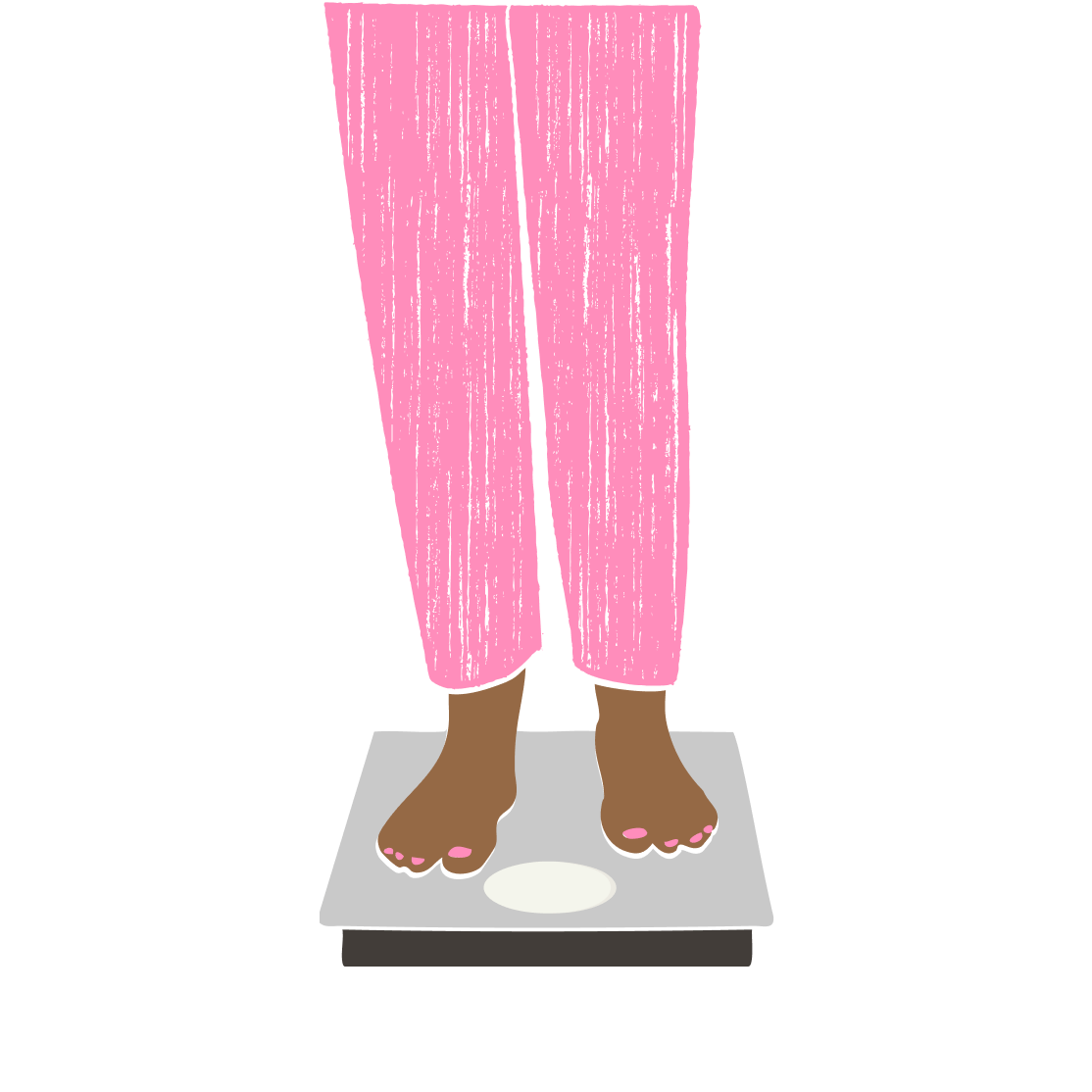Perimenopause symptoms are often dismissed or brushed aside, leaving women feeling confused and without answers. A perimenopause symptom tracker is a practical, empowering tool that puts you back in the driver's seat of your health and opens the door to way more productive conversations with your healthcare professional.
Mood swings that come out of nowhere, periods that ghost you or show up uninvited, energy that's basically subzero, sleep that's more like a wrestling match, and a body that suddenly feels unlike yours. Sound familiar?
These could all be signs that you're in perimenopause—those wild years leading up to menopause. The tricky part? It can be really hard to connect the dots, which is why so many women have no idea their bodies are going through these major hormonal shake-ups in the first place.
That's where a menopause symptom tracker comes in. Having confirmation that you're in perimenopause can bring clarity, give you the tools to advocate for yourself with healthcare professionals, and ultimately lead to better care.
Let's dive into how to track your perimenopause symptoms and use that data to get the support you deserve.
Understanding Perimenopause
Perimenopause is basically the opening act before menopause takes the stage. During these years, the hormones estrogen and progesterone are on a wild rollercoaster ride—sometimes they're up, sometimes they're down, and honestly, they're just as confused as you are. It's these hormonal ups and downs that trigger all those perimenopause symptoms that can make you feel like you're losing your mind.

There's no magic age when perimenopause decides to crash your party. This stage can kick off as early as your 30s or wait until your 50s to make an appearance, though most women start noticing changes in their 40s. Lasting anywhere from 4 to 10 years, perimenopause is like a snowflake—no two women's experiences are exactly alike. Plus, a huge variety of symptoms can pop up, which makes tracking even more valuable.
Most Common Perimenopause Symptoms to Track
We don’t wake up one day and know we’ve entered perimenopause. Nope. For many women, a collection of emotional, physical, and cycle-related changes tip them off to the hormonal shifts of perimenopause being at the root of their symptoms.
Here’s a list of perimenopause symptoms to consider tracking:
- hot flashes and night sweats
- mood shifts, including irritability or anger
- irregular menstrual cycles
- sleep disturbances and insomnia
- brain fog and memory issues
- weight gain
- anxiety and depression symptoms
- low libido and sexual health changes
- urinary symptoms and incontinence
It’s not necessary to track all of these specifically. Menopause has over 100 possible symptoms, so many others might affect you instead. Choose the symptoms that have the most impact on your work, home life, or general sense of well-being and keep tabs on those.
Why You Should Track Perimenopause Symptoms
Every woman's perimenopause journey is as unique as her Netflix recommendations, which is why tracking all the changes happening in your body right now can be incredibly helpful.
Tracking gives you real-time intel on what your body is up to. Having this information at your fingertips helps you become a detective in your own health story.
Helps identify patterns and triggers
You know you're not sleeping well, but what does that actually look like? You've been more irritable than usual, but when exactly? And intimacy has taken a backseat (if it's even in the car anymore), but when did that start happening?
It's totally normal to have a general sense of how you're feeling, but having actual data to back it up is pure gold. This information can reveal what habits and situations might trigger your symptoms. Maybe every time you have that glass of wine with dinner, you're up all night sweating. Or perhaps each time you see dishes in the sink, you feel inexplicable rage. Tracking helps you connect these dots.
Makes doctor visits way more productive
If you've ever sat in a doctor's office, drawing a complete blank about your symptoms, forgotten your important questions, or cheerfully said "Nope, everything's fine!" when asked if there's anything else bothering you, you're not alone.
Having data in hand turns those appointments into focused, productive conversations. You'll have specifics about what you're feeling, how often it occurs, and when it happens. This helps your healthcare professional get to the root of what's going on—and that's where real solutions can begin.
Gets you personalized care that actually helps
The whole point of perimenopause treatment is helping you feel like yourself again and reducing long-term health risks. Sometimes that means hormone therapy, other medications, supplements, lifestyle tweaks, or a combo approach. When you know exactly which symptoms are making your life difficult, your menopause specialist can create a treatment plan that's actually tailored to you, not some generic one-size-fits-all approach.
Catches problems early
It's pretty hard to ignore or downplay mood swings, sleep troubles, brain fog, or hot flashes when you have a tracker full of evidence. Research backs this up big time—one study of 100 women in perimenopause or postmenopause found that those who tracked their daily symptoms and emotions saw a 42% reduction in physical symptoms, compared with just 12% in the control group after 2 weeks. The tracking group also reported feeling less negative overall.
Puts you back in control
Menopause has been brushed under the rug for way too long. About half of women never even talk with a healthcare professional about menopause—there's still stigma and shame around symptoms, plus many women don't realize that what they're experiencing is actually related to menopause.
Once you see the patterns laid out in front of you, it becomes crystal clear that your symptoms are real, they're affecting your quality of life, and they absolutely deserve attention and treatment. A symptom tracker becomes your ultimate self-advocacy tool.
Research published in Digital Health found that women using menopause apps felt "empowered…with an increased sense of confidence and knowledge about their own menopause experience."

How Tracking Symptoms Helps with Diagnosis and Treatment
Hormones fluctuate so wildly in perimenopause that lab tests are often an unreliable marker of where your estrogen is on its rocky decline. Some days it’s up, some days it’s down. That’s why, in most cases, the best way for your clinician to understand what you’re going through is via your self-reported symptoms. Documenting exactly what you’re experiencing and when can help give your healthcare team a roadmap.
- During diagnosis: Your detailed symptom log helps healthcare professionals accurately diagnose perimenopause, leading to earlier intervention and better long-term outcomes.
- Throughout treatment: Tracking shows you whether treatments like hormone therapy are working their magic or if adjustments are needed. You can also keep tabs on any side effects.
Ways to Track Your Symptoms
Just like how some people are digital calendar devotees while others swear by their paper planners, symptom tracking comes in different flavors:
- “Old-school” tracking: Grab a journal, notebook, or symptom diary and jot down the details—what symptoms you're having, when they show up, how intense they are, and any possible triggers.
- Online checklists: You can find tons of menopause symptom checklists online, which you can use to assess what you're experiencing. Many are available as printouts, too.
- Apps: Menopause apps are like having a personal health assistant in your pocket, offering symptom tracking, educational info, expert advice, and more.
- Wearable trackers: Devices like the Oura Ring can track a variety of health and wellness markers, including how much you move and how well you sleep. Oura members can easily share their Perimenopause Report with Midi clinicians to help inform a personalized Care Plan, which may include hormonal or non-hormonal treatments, supplements, lifestyle coaching, and more.
What to Look for in a Menopause Tracker App
Choosing a menopause app? The key is finding one you'll actually want to use consistently. Here's what makes an app worth your time:
- Simple, intuitive interface that doesn't require a PhD to navigate
- Comprehensive symptom checklist with options to add your own
- Menstrual cycle tracking capabilities
- Space to log medications, supplements, and treatments
- Room to note lifestyle factors (diet, exercise, sleep habits)
- Cool data visualization (charts, graphs, scores) to spot patterns
- Secure, private data storage (because your business is your business)
- Easy-to-share reports for healthcare visits
- Community connections with other women going through the same thing
- Educational resources that actually make sense
Why Digital Trackers Are Pretty Great
Going digital has some serious perks:
- Convenience: Quick and easy to update wherever you are—no hunting for that notebook you swore you left on the kitchen counter.
- Education: Up to 80% of medical information from healthcare visits is forgotten immediately. Half of what we do remember isn't even accurate (and that's not menopause brain fog talking, it's just how human brains work!). Apps often provide reliable menopause information right alongside the tracking features.
- Better accuracy: Digital apps keep everything organized, which can be challenging with manual tracking.
- Friendly reminders: Apps can nudge you to log your symptoms, which is crucial for spotting patterns.
- Visual insights: Many apps turn your data into easy-to-understand charts and graphs, giving you those "aha!" moments about your symptoms.
- Healthcare communication: The organized way apps present information makes it easy for your healthcare professional to quickly understand what's going on
Tips for Effectively Tracking Your Perimenopause Symptoms
Get the most bang for your tracking buck with these strategies:
- Make it daily: Find a rhythm that works for you—maybe logging symptoms as they happen throughout the day or doing a quick body check-in before bed.
- Get detailed: Instead of writing "tired," try "so exhausted I canceled dinner with friends." The specifics really matter when you're trying to understand your patterns, so include how severe your symptoms are, how often they happen, and what might have triggered them.
- Stay engaged: Check in regularly with your health data. Look at reports, scores, charts—whatever insights your tracking method provides.
- Share the wealth: Bring your symptom patterns to a menopause-savvy clinician (like the team at Midi Health) to get personalized support and create a treatment plan that's all about you.
Key Takeaways
- Tracking your perimenopause symptoms—whether on paper, in your phone's notes, or through an app—means recording what you're experiencing, how intense it is, and what might be triggering it.
- This kind of tracking puts you back in control of your experience and helps you show up prepared for those important healthcare conversations.
- Research consistently shows that women who track their perimenopause symptoms experience fewer physical symptoms and less emotional distress.
- The real win? Sharing this data with a menopause specialist leads to more personalized care, better diagnosis, more effective treatment plans, and adjustments when needed.
Frequently Asked Questions (FAQs)
What is the average age of menopause?
On average, a woman reaches menopause at age 51. Menopause is defined as going 12 consecutive months without a period.
What are the seven early signs of menopause?
Early signs of menopause occur when you are in perimenopause, the stage of life before the menopausal transition. Early and common signs of perimenopause include irregular and unpredictable menstrual cycles, brain fog and memory problems, weight gain, fatigue, hot flashes/night sweats, mood shifts, and sleep difficulties.
What are the five stages of menopause?
Actually, there are three main stages: perimenopause, menopause, and postmenopause. Some practitioners break it down further into early and late transitions, but honestly, that can make things more complicated than they need to be. You don't have to put yourself into specific categories to understand your symptoms and get the right treatment.
How do I know if my symptoms are menopause?
You don't need to figure this out solo! The best move is to connect with a menopause-trained clinician, who will consider your health history and symptoms to determine whether what you’re experiencing is caused by shifting hormones during the menopausal transition.
If you’re in perimenopause or menopause and want guidance from clinicians who specialize in women’s midlife health, book a virtual visit with Midi today.
Hormonal change is at the root of dozens of symptoms women experience in the years before and after their period stops.
Our trained menopause specialists can help you connect the dots to guide you towards safe, effective solutions.
Whether you need personalized guidance or a prescription routine to tackle symptoms—including brain fog, hot flashes, sleep trouble, mood swings, and weight gain—we’ve got you covered. Learn more here.
Midi’s mission is to revolutionize healthcare for women at midlife, wherever they live and whatever their health story. We believe that starts with education, to help all of us understand our always-changing bodies and health needs. Our core values guide everything we do, including standards that ensure the quality and trustworthiness of our content and editorial processes. We’re committed to providing information that is up-to-date, accurate, and relies on evidence-based research and peer-reviewed journals. For more details on our editorial process, see here.









